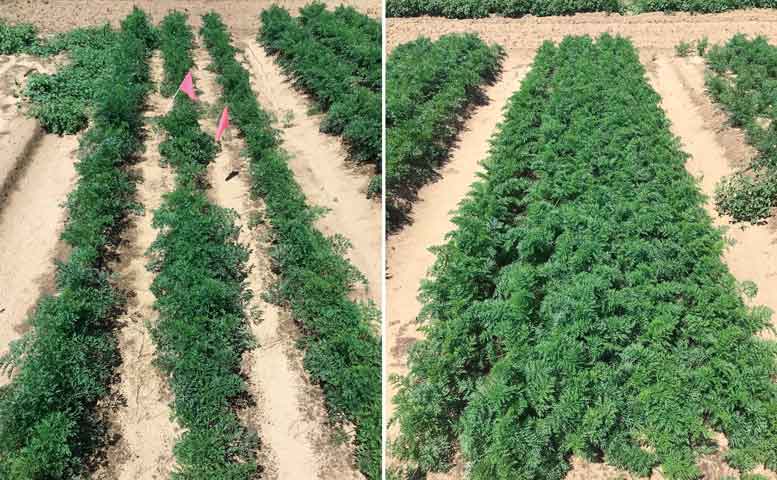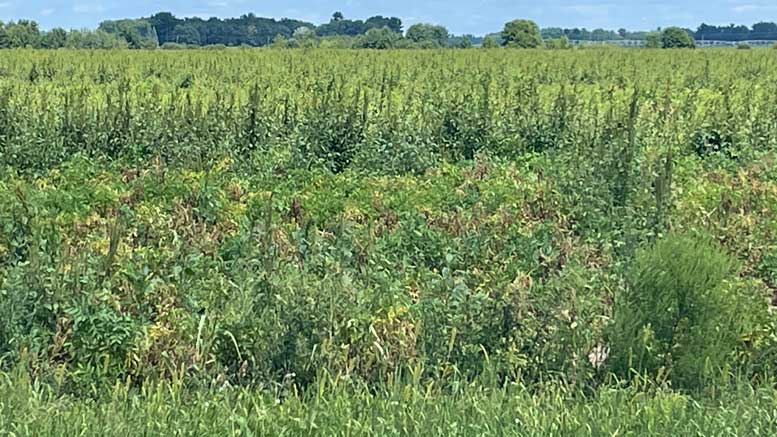|
Click to listen to this article
|
By Jed Colquhoun, Professor and Extension Specialist, University of Wisconsin-Madison
Managing weeds in carrots has always been a significant challenge for several reasons. First, the crop itself is a tortoise racing against weeds that are like hares. Carrots emerge very slowly and non-uniformly, particularly in cool weather, and often take several weeks to form a canopy that can compete with weeds. Secondly, control options are limited. Early-season cultivation is challenging, given that the weeds grow faster than the carrots, creating a size differential where early cultivation puts the crop at risk of “cultivator blight,” while waiting for the crop to size up to minimize that risk allows weeds to grow beyond the capabilities of tillage. Herbicide options, like in many minor crops, are limited to only a few viable tools, some of which are further restricted where groundwater contamination risk is high. Hand-weeding is excessively expensive, if labor is even available, and not a realistic long-term option across large acreages.
In most carrot producing regions, including the Upper Midwest U.S., weed control challenges are increasing exponentially with widespread selection for herbicide-resistant weeds. In the Upper Midwest, this is particularly true for Amaranthus species such as redroot pigweed and, more recently, waterhemp. Weeds resistant to the photosystem II (PSII) herbicide site of action are especially problematic, given that three of the most common herbicide active ingredients used in carrot fall in that group: linuron, metribuzin and prometryn. Waterhemp resistance to seven herbicides sites of action has now been reported globally, including multiple populations with resistance to six sites of action in individual plants. Some more recent cases include metabolic resistance, such as to the active ingredient s-metolachlor that is used in carrots, where resistant waterhemp uses generalist enzymes found in most organisms to detoxify or “digest” the herbicide and other plant stressors. While metabolic resistance sounds like something out of a sci-fi movie, it’s real and happening, and it means that these amped-up weeds can metabolize herbicides that have never been sprayed on them before – or have yet to be invented.

Management Strategies
So what does this mean for the future of carrot weed management? By necessity, it will be different and will need to incorporate new strategies that complement or are alternatives to current herbicides. With that said, there are several “low-hanging fruit” strategies that can be adopted with minimal additional inputs or cost. Here, we outline a few of these strategies from a compilation of studies we have conducted in Wisconsin over the last several years, including a large factorial study that investigated carrot cultivar choice, row density, seeding timing and use of plant growth regulators to stimulate canopy development.
- Go fishing. Yes, you read that correctly! By far, our best weed control across the season happened when we delayed seeding for two weeks (from late April to mid-May in Wisconsin). Carrot emergence was much faster and more complete in warmer mid-May conditions than late April and, as a result, the crop canopy closed earlier and suppressed weeds. We’re not alone in this observation; similar results have been reported by Canadian researchers, and growers note anecdotally that later planted carrots have far fewer weed issues than their earlier plantings.
- Choose competitive cultivars. Carrots, like most crops, have traditionally been bred for end-use characteristics: high usable yield and good quality. Resources that plants put into below-ground growth can come at the cost of foliar growth. For example, in related research, we found that potato canopy development was much more complete in the original Russet Burbank line from 1885 compared to modern cultivars, and this impacted their ability to tolerate or suppress weeds. We’ve had similar observations in our work with carrot breeders. So, choose a variety that emerges rapidly, grows quickly and forms a complete canopy, without compromising yield and desirably with good foliar disease resistance; the results are like mulching the ground but with the carrot canopy that intercepts light, water and nutrients before they reach weeds.
- Increase the number of rows per bed. There are two benefits to this approach. First, denser plantings suppress weeds well. Second, in a system where most inputs are broadcast such as irrigation, crop protectants and fertilizer, the system is simply more efficient, where a grower can get more yield out of the same amount of land and inputs. Why pay for fertilizer, water and other inputs that weeds can use but not the crops? Just be sure to pick a carrot cultivar with good foliar disease resistance; dense plantings can become a plant pathogen humidor of sorts. And it’s acknowledged that increasing the number of seeded rows per bed requires planter and harvester equipment changes that are extremely costly, so maybe this is a consideration when it’s time for new steel in the field.
New Technology
Looking forward, weed management in minor crops is on the verge of a paradigm change. There simply aren’t a lot of new herbicide sites of action or even new active ingredients coming along. Meanwhile, great advances are being made in practical applications of remote sensing, automated robotics and alternative control tools. New automated sensing technology can detect in real-time the difference between weeds and crops with sub-millimeter accuracy. Automated robotics are becoming common in high-value minor crops where labor isn’t available. The best part: robots don’t complain and can work 24 hours a day. And finally, innovative management tools are now commercially available, such as lasers and electrocution for weed control. Sure, there are still advances to be made and like any new technology, the first commercial products can be expensive, but keep in mind that the first cell phone introduced in 1983 weighed 2.5 pounds and cost over $10,000 in inflation-adjusted USD. These, and other innovations, will help us bridge the gaps in current conventional weed control and greatly expand options for organic producers. In the meantime, take advantage of the low-hanging fruit, and enjoy the fishing!

